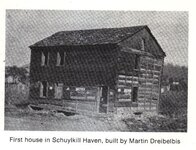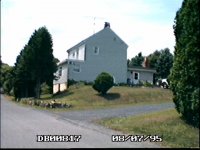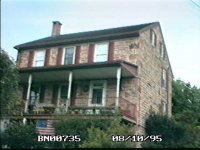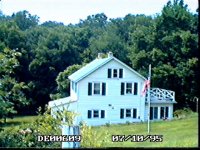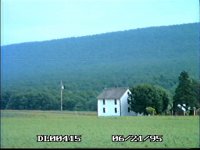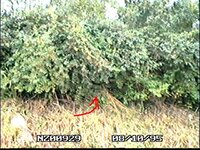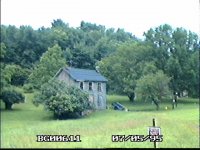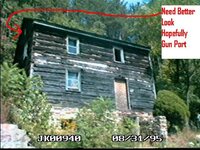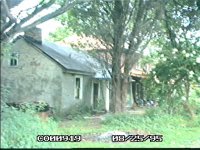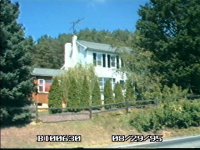cuddles17981
Full Member
In 1776 the people of the province of Pennsylvania threw off the proprietary government and adopted a state constitution; then, by a series of acts the last of which was passed January 28th, 1779, the estates of the proprietaries under the charter were vested in the commonwealth, and the feudal relation which the charter created was entirely sundered. This act was similar in its character to the Declaration of Independence, and like that declaration its force depended on the success of the Revolution. It appears that manorial lands had been held and sold in this county prior to the Revolution, and that individuals had acquired titles to ether lands from the proprietaries; but the titles to most of the lands in the county were obtained from the State by procuring warrants directed to the surveyor general and by him transmitted to the deputy-surveyor of the district, authorizing a survey of the lands described in the applications for the warrants. On the return of these warrants and compliance with all the prescribed conditions patents or letters patent (open letters) were granted, conveying the title in fee simple to the patentee. This has been the usual method of acquiring titles from the State. It is hardly necessary to speak of titles acquired by location, by settlement or by improvement. Warrants were not granted to one person at the same time for larger tracts than four hundred acres, but to evade this regulation, speculators often made applications for lands in different names and made the necessary transfers afterward, thus acquiring titles to large tracts.
Before the mineral wealth that lies beneath the surface here was known many lands were sold for arrears of taxes. Of these some that were purchased at two or three cents per acre have now a value per acre of $1,000 or more.
When the first settlers penetrated the region north from the Blue mountain, or who those settlers were, is not known. It has always been true that the pioneers of civilization have pushed forward in advance of treaties, and located at their own peril where advantages of soil, climate, or other circumstances served to invite. The region south from Blue mountain, now Berks county, had many settlers previous to the extinguishment of the Indian title in 1736, and that portion of Schuylkill between Blue and Second mountains is known to have been settled by many whites before its purchase in 1749. Early in that year a grand council of the Six Nations at Onondaga had a deputation of chiefs from each of these nations go to Philadelphia and represent, among other things, that settlements had been made by the whites on this side of the Blue mountain. They said: "As our boundaries are so well known and so remarkably distinguished by a high range of mountains we could not suppose this could be done by mistake; but either it must be done wickedly, by bad people, without the knowledge
of the governor, or the new governor has brought some instructions from the king or the proprietaries relating to this affair whereby we are to be much hurt. The gov ernor will be pleased to tell us whether he has brought any orders from the king or proprietaries for these people to settle our lands; and if not we earnestly desire that they be made to remove instantly, with all their effects, to prevent the sad consequences which will otherwise ensue."
North from Second mountain there was nothing then to invite settlement. The existence of coal was not known. No demand had arisen for the lumber which that region was capable of affording, and the surface was too rugged and mountainous for successful agriculture. Here and there might be found the solitary cabin of an adventurous hunter, whom the abundance of game had attracted hither, but nothing more.
Of the early settlers in that part of Schuylkill county south from Second mountain it is known that George Godfried Orwig and Glora, his wife, had come from Germany in 1747 and settled at Sculp Hill, a short distance south from Orwigsburg, which was founded by Peter Orwig, a son of this pioneer couple, in 1796. Some of the descendants of this family still reside in the region. Of other early settlers it is known that Thomas Reed came as early as 1750, a family named Yeager about 1762, and that Martin Dreibelbis had erected a saw-mill and grist-mill at what is now Schuylkill Haven just before the Revolution.
But one dwelling house is known to have been erected in the last century in what are now the coal districts of the county. This was the log house of a Mr. Neiman, whose family was massacred by the Indians about the close of the Revolution. A saw-mill was erected at Pottsville prior to 1800, and another near St. Clair by George Orwig. This was operated without the establishment of a residence there. Provisions for a week were taken to the mill by the workmen, who were thus enabled to manufacture all the lumber which the exigencies of the times required. Probably other mills were built and operated in the same way.
As before stated, the population north from Blue mountain was very sparse at the time of the Revolutionary war, and no revolutionary history of the region is preserved. There are traditions of a few Indian murders and massacres, which are noticed in the histories of the localities where they occurred; but aside from these the region which Schuylkill county includes was not the theatre of hostile operations. What was termed the " Tory path " traversed the county from southeast to northwest. Possibly it may have been an old Indian trail, but its name is suggestive of its use during the Revolution.
In the war of 1812 Schuylkill was represented in the armies of the country by many recruits, but accurate lists of them cannot now be obtained.
There is about 500 pages
http://books.google.com/books?id=fy...i=book_result&resnum=9&ct=result#PRA1-PA73,M1
More about the massacre
http://books.google.com/books?id=ei...X&oi=book_result&resnum=4&ct=result#PPA159,M1
Before the mineral wealth that lies beneath the surface here was known many lands were sold for arrears of taxes. Of these some that were purchased at two or three cents per acre have now a value per acre of $1,000 or more.
When the first settlers penetrated the region north from the Blue mountain, or who those settlers were, is not known. It has always been true that the pioneers of civilization have pushed forward in advance of treaties, and located at their own peril where advantages of soil, climate, or other circumstances served to invite. The region south from Blue mountain, now Berks county, had many settlers previous to the extinguishment of the Indian title in 1736, and that portion of Schuylkill between Blue and Second mountains is known to have been settled by many whites before its purchase in 1749. Early in that year a grand council of the Six Nations at Onondaga had a deputation of chiefs from each of these nations go to Philadelphia and represent, among other things, that settlements had been made by the whites on this side of the Blue mountain. They said: "As our boundaries are so well known and so remarkably distinguished by a high range of mountains we could not suppose this could be done by mistake; but either it must be done wickedly, by bad people, without the knowledge
of the governor, or the new governor has brought some instructions from the king or the proprietaries relating to this affair whereby we are to be much hurt. The gov ernor will be pleased to tell us whether he has brought any orders from the king or proprietaries for these people to settle our lands; and if not we earnestly desire that they be made to remove instantly, with all their effects, to prevent the sad consequences which will otherwise ensue."
North from Second mountain there was nothing then to invite settlement. The existence of coal was not known. No demand had arisen for the lumber which that region was capable of affording, and the surface was too rugged and mountainous for successful agriculture. Here and there might be found the solitary cabin of an adventurous hunter, whom the abundance of game had attracted hither, but nothing more.
Of the early settlers in that part of Schuylkill county south from Second mountain it is known that George Godfried Orwig and Glora, his wife, had come from Germany in 1747 and settled at Sculp Hill, a short distance south from Orwigsburg, which was founded by Peter Orwig, a son of this pioneer couple, in 1796. Some of the descendants of this family still reside in the region. Of other early settlers it is known that Thomas Reed came as early as 1750, a family named Yeager about 1762, and that Martin Dreibelbis had erected a saw-mill and grist-mill at what is now Schuylkill Haven just before the Revolution.
But one dwelling house is known to have been erected in the last century in what are now the coal districts of the county. This was the log house of a Mr. Neiman, whose family was massacred by the Indians about the close of the Revolution. A saw-mill was erected at Pottsville prior to 1800, and another near St. Clair by George Orwig. This was operated without the establishment of a residence there. Provisions for a week were taken to the mill by the workmen, who were thus enabled to manufacture all the lumber which the exigencies of the times required. Probably other mills were built and operated in the same way.
As before stated, the population north from Blue mountain was very sparse at the time of the Revolutionary war, and no revolutionary history of the region is preserved. There are traditions of a few Indian murders and massacres, which are noticed in the histories of the localities where they occurred; but aside from these the region which Schuylkill county includes was not the theatre of hostile operations. What was termed the " Tory path " traversed the county from southeast to northwest. Possibly it may have been an old Indian trail, but its name is suggestive of its use during the Revolution.
In the war of 1812 Schuylkill was represented in the armies of the country by many recruits, but accurate lists of them cannot now be obtained.
There is about 500 pages
http://books.google.com/books?id=fy...i=book_result&resnum=9&ct=result#PRA1-PA73,M1
More about the massacre
http://books.google.com/books?id=ei...X&oi=book_result&resnum=4&ct=result#PPA159,M1



